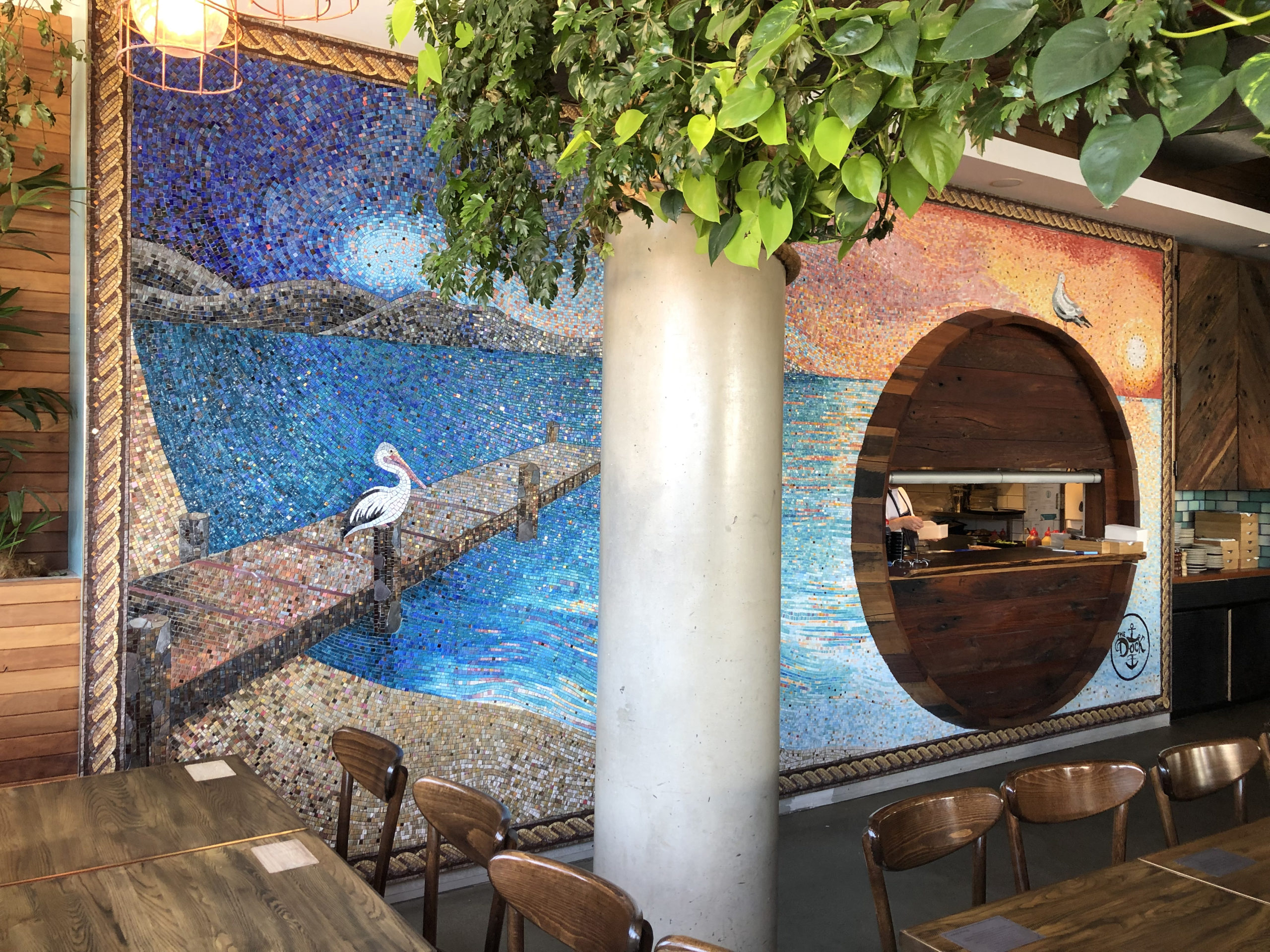
The Dock Mural
2019, The Dock, Giles Street, Kingston Foreshore, Canberra, ACT, Australia
Caitlin Hepworth
Hazelbrook, NSW, Australia
600 x 300 x 1.8 centimeters
Mexican and Italian smalti, marble, travertine, limestone, unglazed porcelain, sandstone, oro, slate
In May 2018, I was commissioned to create a large mosaic mural for ‘The Dock’, a restaurant and sports bar on the Kingston Foreshore in Canberra. The client was updating their interior and wanted to reflect the venues waterfront location, bringing in the freshness and light of Lake and mountains beyond. They wanted to soften the atmosphere of the interior to attract family and corporate clientele. The renovations extended to tables, tiling, soft furnishings and more. The clients wanted the colours and rope motifs used elsewhere to be incorporated into the design with a 12cm x 1800cm rope border around the perimeter, as well as the inclusion of teals, blue and bronzes seen throughout the restaurant.
Following initial discussion, I prepared a small watercolour painting of the proposed composition which captured the mood intended and was approved by the clients.
I created digital renderings of the sketch in-situ to provide a good idea of the overall effect. The desire for high quality products, texture and reflectivity led us to the decision to work predominantly in a blend of Mexican and Italian smalti. At the clients request, the mural was framed with a rope look border, which was created in a blend of nine colours of marble.
The large timber serving window was a permanent fixture on the wall and posed a large design challenge as it needed to be incorporated into the design. To balance its visual weight, I created a jetty running from the shore on the other side of the design. To connect the large heavy window with the lake scape, I included a large seagull perched on the window, who appears to have had flown out of the scene, ready to steal the customers fries from the serving window below. The seagull was balanced by a pelican (further back in the compositional perspective) to help develop scale as well as help create a foreground, middle ground and background.
The composition was created mainly along the rule of thirds with the skyline at the junction of the top two thirds the bottom 2/3 of the composition is sea and beach. The beach is brought up on the LHS to bring the viewers eye up and around the composition and to mimic the curve of the window.
I focused on the sunset in the sky placing the sun on the right hand side, which is directly above the logo and in a straight line of sight when you enter the restaurant. The circular nature of the sun balanced the logo and connected to the window. I found I needed to put a balancing circular swirl on the other end of the sky and did so in the form of the swirling night sky.
I created a 6m x 3m hand drawn scale drawing on paper, then sectioned the design, and worked with a team of artists and students from my school over a 4 month period, to fabricate the mosaic, directly onto mesh with thinset. We used using nearly 200kg of smalti, 90 000 pieces in over 100 beautiful colours. This method allowed us to create transportable, self-supporting sections, which could then be adhered directly to the wall and joined during a 6 day installation period.
The original wall was gyprock and needed to be replaced with cement sheeting and reinforced for a tiled wall of 300kg. (approx. 200kg of material and 100kg of adhesive). This was then sealed with bondcrete. A metal tile edging was attached to the exterior edge to help protect the edge of the marble border as the Pepperino Rosso (which was the exterior edge tesserae and was vulnerable). The handmade timber window provided further complexity as its irregular shape and rough edges could not be templated. The cement sheet only roughly met the timber window surround leaving substantial and irregular gaps. This had to be patched and filled significantly on arrival (an unexpected task as I had assumed the trades people would have completed the wall properly). The mosaic around the timber window had to be completed on site, as did the position of the seagull as it had to have its feet exactly on the edge of the timber frame, then mosaiced around with the andamento accurately meeting up with the flow of the surrounding sky. The installation period was 6 days. The restaurant closed for one day only. We were working in and around clientele, waitstaff, bar staff, and kitchen staff.
Fabrication and installation assistance was provided by a core team of Hughes Studio artists and students including April Keogh, Linda Weiss, Cindy Topic, Mario Gauci, Vicky Bush, Zuzia Baran and Georgina Findley.

